antibody/immunoglobulin diversity and structure
chp 4 textbook
clonal selection hypothesis
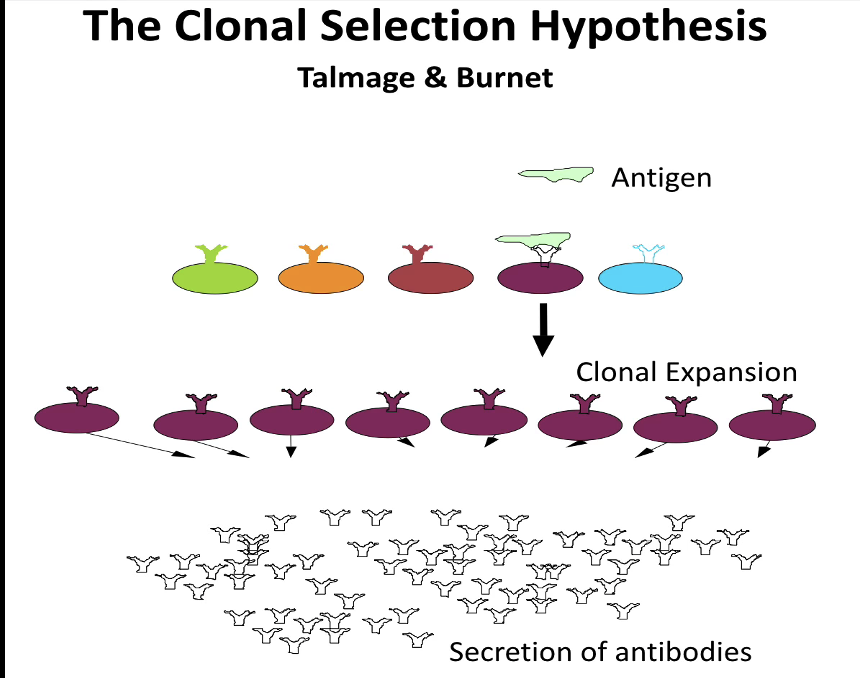
Why lymphocytes and B cells premade for all eventualities
Not antibodies when created as specific molecules: are receptors on B cell
- all B cells are born with Igm (no B cell does NOT have B cell receptor, ALL B cells have it)
- if try to delete light chain genes: then no B cells were created in the animal/etc
Clonal selection vs expansion
- 5 B cells shown
- pathogen antigen shows up, one of the B cells has the BCR for the specific antigen -> binds to antigen
= recognition phase (when antibody is Igm still sitting on B cell (the point where it is the B cell receptor))
- B cell do nothing unless interact w/ antigen it was made for -> proliferate (clonal expansion) (up to 10 million made per day)
- antigen signal triggers some B cell to become antibody secreting cells -> secrete the antibodies
Clonal selection vs clonal expansion
Selection – when the lymphocyte is chosen by the antigen
Expansion – proliferation that occurs due to antigen selection/interaction
Key message -> The templates (Abs) are pre-formed against all antigens
antibody
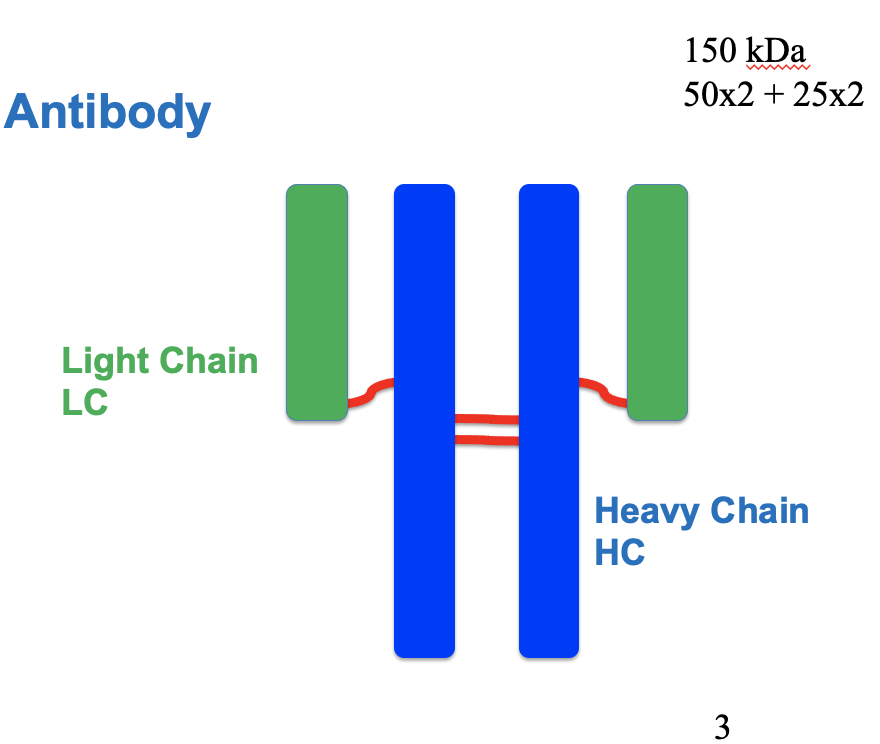
2 proteins of polypeptides
- light chain
- heavy chain
antibodies made of combining light and heavy chain
uniqueness of antibody molecule as receptor = has 2 identical binding sites
- light and heavy chain dimerized to make antibody
- has 2 antibody binding sites
- good bc one can be vacant while the other is attached to a pathogen = can attach to 2 pathogens = aggregation
what is antibody composed of? = heavy and light chain
what are they held together by: disulfide bonds (the red, covalent bond, stabilizes molecule and keeps its shape)
antibody = 150 kDA
light chain = 25 kDa (x2)
heavy chain = 50 kDa (x2)
antibody is made up of variable and constant domains
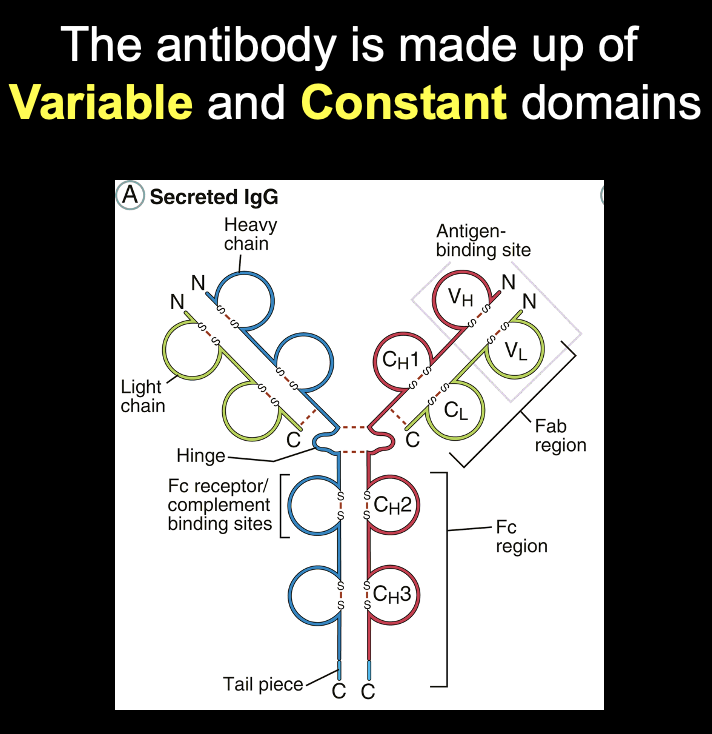
Lower part of heavy chain – same in all antibodies
Constant part of light chain does not change
Specificity is in the variable heavy chain and light chain parts (towards the tips)
Each heavy chain has two regions, the constant region and the variable region. The constant region is identical in all antibodies of the same isotype, but differs in antibodies of different isotypes
The variable region of the heavy chain differs in antibodies produced by different B cells, but is the same for all antibodies produced by a single B cell or B cell clone
A light chain has two successive domains: one constant domain and one variable domain
Each antibody contains two light chains that are always identical
antibody binding site is hypervariable
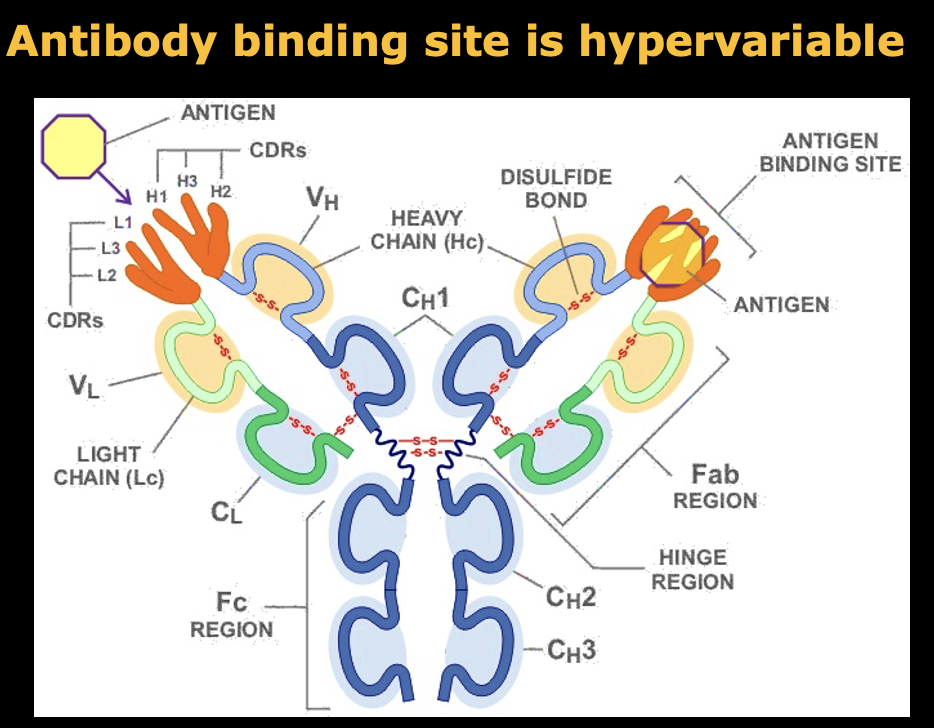
2 things about Ab: globular structure which is stable but also highly flexible allowing formation of finger-like loops that can be short or long as needed
Antigen binding sites are like fingers, can bind all kinds of structures
- antibodies see shapes (don’t care if its certain amino acid sequences, lipids, chemical, etc.) bc it depends on shapes
- structure versatile and flexible
antibody bound to antigen pic
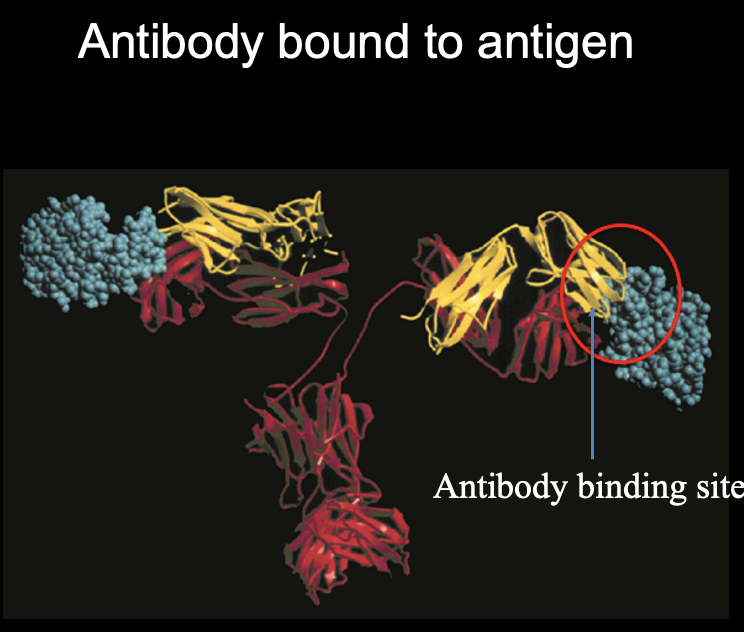
Antibody make beta pleated sheets
- alpha helices give structure of antibody as fully folded primary protein
Pic shows antigen binding to light and heavy chain (circled in red)
formation of antigen bindng site of heavy chain (VH domain)
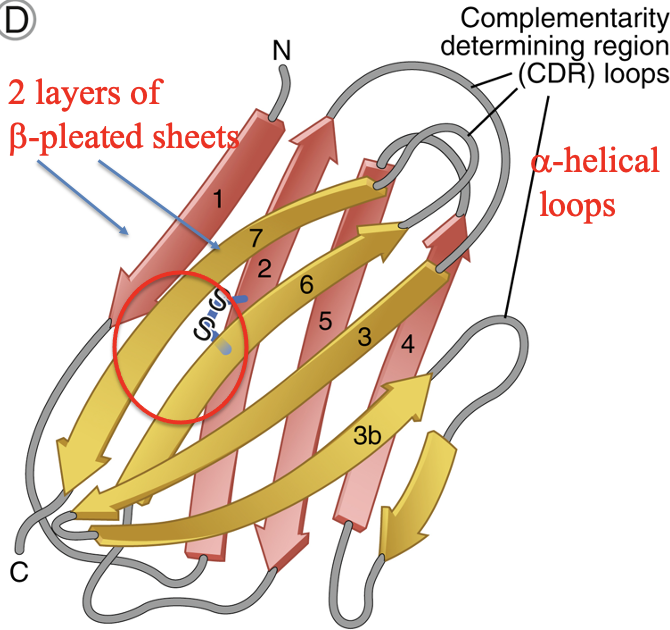
Beta pleating is not variable
So variability lies in the alpha helices
Ig (immunoglobulin domain) is made up of the betas pleated sheets and alpha helical loops, and the alpha helical loops determines the variability in the binding site
CDR – complimentary determining regions (the loops, which are the alpha helical regions)
- each loop has number (1,2,3)
- protein structure complimentary to the antigen will bind
closer view of V and C regions of antibody structure
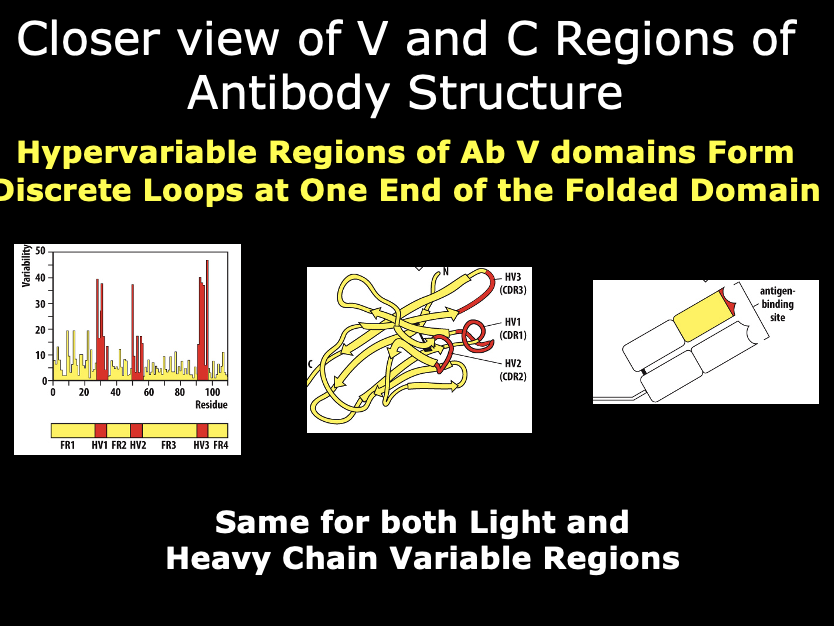
Hypervariable Regions of Ab V domains form discrete loops at one end of the folded domain
same for both light and heavy chain variable regions
variability is in that region based on reasoning from last slide
Certain parts of antibody sequence where most variability is (red parts)
- in loops, and makes up antibody binding site (see pic on right)
formation of the antigen binding site of heavy chain (VH domain)

- this is a favorite protein fold
The diversity and structure of antibodies gives extreme felxibility/adaptability
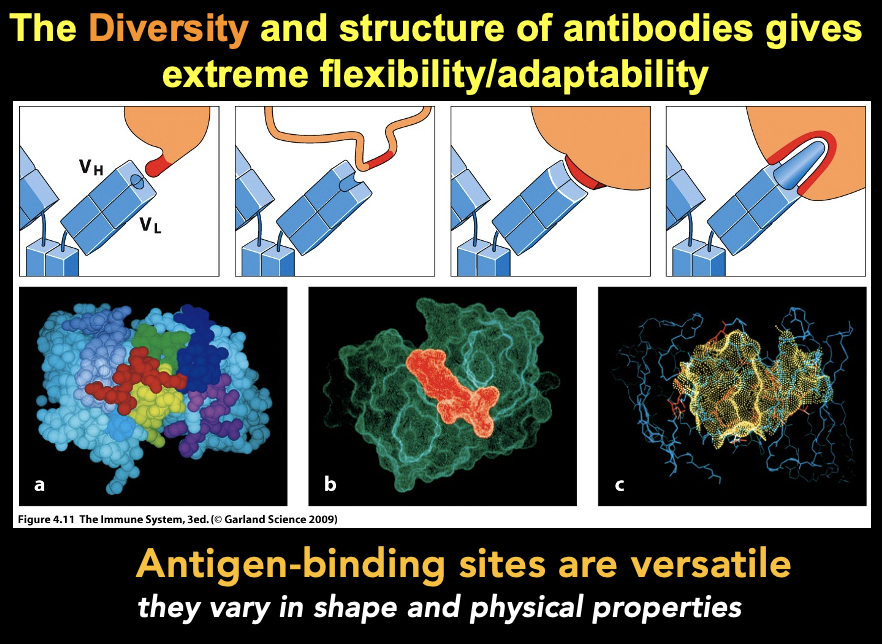
antigen-binding sites are versatile
vary in shape and physical properties
Binding site can be diff shapes in order to be specific for the antigen
Ab binding sites can bind linear and discontinuous epitopes
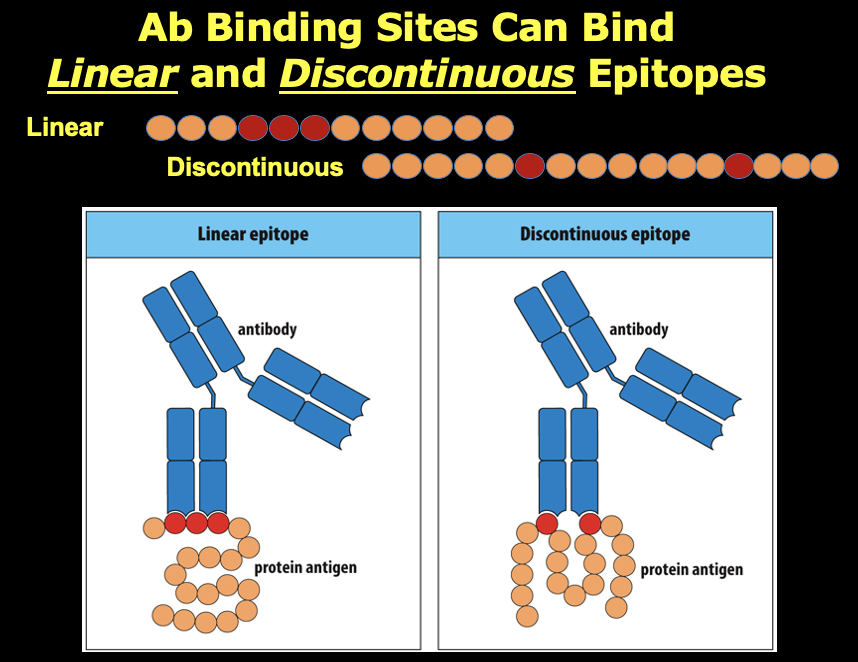
Proteins folded into their shapes
Antibody binding sites can bind to antigen if it is a linear sequence of antigen protein, or even if it is discontinuous (if the specific shape made has the structure they recognize, bc the shape matters)
BIG contrast to T cell receptor – see proteins ONLY, and recognizes based on the linear peptide
What kind of molecules can antibodies bind to?
Is the antibody binding determined by sequence or shape?
almost any/any molecules
bc it only binds depending on the shape (binds to specifically shaped antigen)
lymphocyte development
Antigen gives instruction to B cell to expand clonally
Antigen to BCR is a bit more than this
If delete BCR from B cells, then no B cells exist if delete the gene
If B cell does not make heavy chain, this happens
Same true for T cells
cell membrane IgM (BCR) signaling guides B cell development
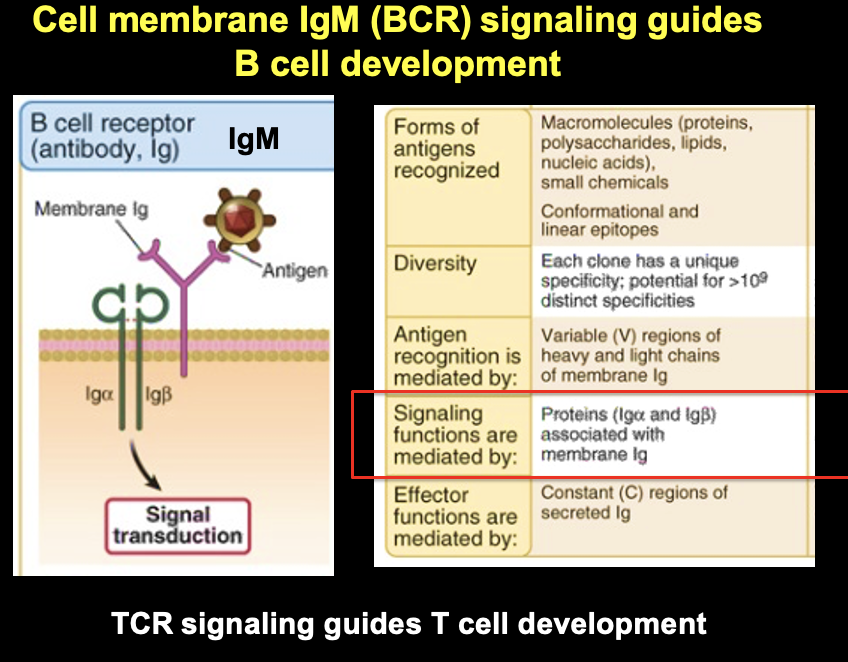
BCR signals cell to do changes intracellularly -> make antibodies/differentiate
TCR signaling guides T cell development
steps in B cell and T cell development
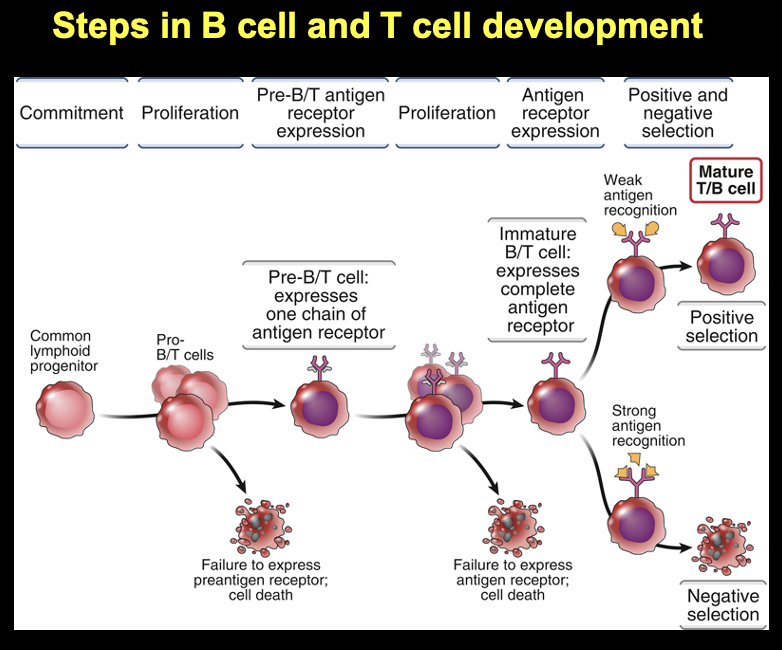
Progenitor -> B or T cells
- if it cannot make a little precursor receptor on the pre B/T cell, then the B/T cell dies
- must have the receptor to survive and develop
- receptor sends signals for development in cell (bc if not, cell dies)
- if have the receptor -> matures
Then goes on
If dev to be dangerous to our body -> it dies (negative selection)
If its fine -> positive selection and survives
heavy and light chain expression during B cell ( and T cell ) development
TCR – make TCRbeta chain first
- next make TCRalpha chain
BCR - make VH chain first
- next make VL chain
many receptors made will likely die due to no use – never finds its antigen
If react to own antigen and has strong signal, cells picked to die if there is strong reaction to antigens (negative selection)
positively selected for weaker antigen recognition -> go on to mature as B or T cell
Antigen receptor tickling – receptors always tickling cells they are on, keeps them alive??? I think this was a tangent so doesn’t matter???
Generation of a large B cell repertoir with diverse antigen receptors
antibody (immunoglobulin) repertoir diversity is 10^11
human and mouse genomes and gene stats
humans have 58 thousand genes
only 19950 code for proteins
how is it possible to make so many receptors??? How can the 10^11 different receptors be made (out of proteins, bc the chains are proteins) if we only have 19950 protein encoding genes?
prototypical gene expression
chromosome has DNA/genes -> mRNA -> polypeptide -> folded protein
our genome not large enough to contain 10^11 genes
There are about 20 thousand protein-coding genes in our genome.
How can 1011 antibodies with distinct specificities be made?
Antibodies obtain their diversity through 2 processes. The first is called V(D)J (variable, diverse, and joining regions) recombination. During cell maturation, the B cell splices out the DNA of all but one of the genes from each region and combine the three remaining genes to form one VDJ segment.
generation of diversity question
susumu tonegawa
took DNA out of B cells
- ran DNA on electrophoresis, migrate, noticed differences in DNA bc of slower/faster movement in electrophoresis
- looked at light and heavy chains
- noted genome of B cells was diff between the B cells
- discovered that basically each cell carries new/different genes
now, how did the DNA change in each cell???
Ig gene pieces (segments) are arrayed in the chromosomes and are randomly recombined to create novel Ig genes
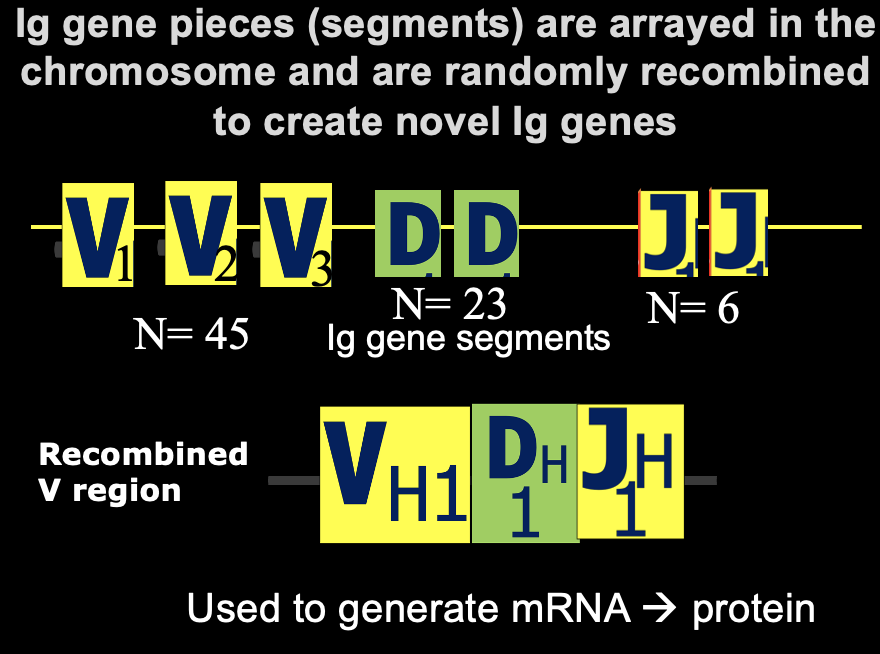
V – variable genes
D – diversity genes
J - joining genes
Turned out – assembled heavy chain – combination of 1 V, 1D, and 1J together
randomly combine a V, a D, and a J together
resulting recombined region is used to generate mRNA -> and then create protein
germline organization of the B cell receptor gene Heavy Chain locus
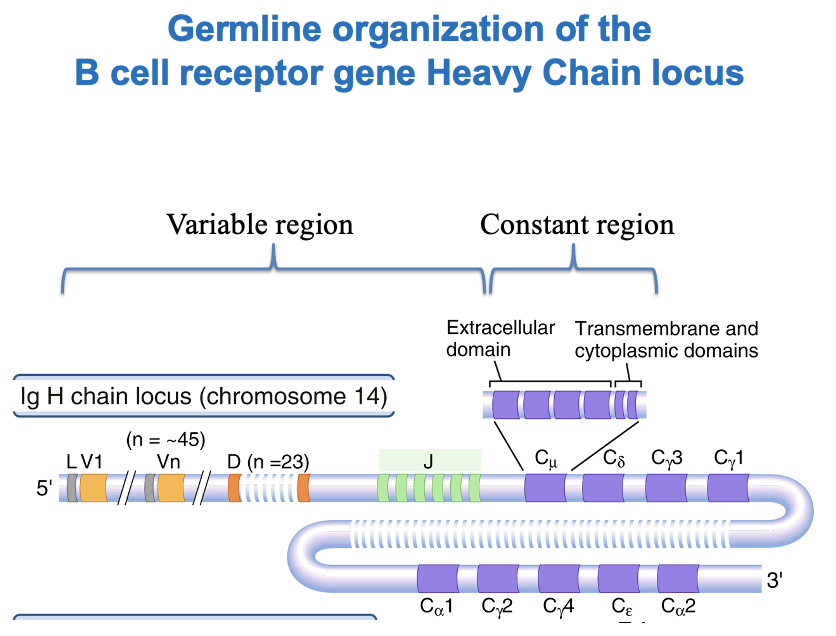
only in B cells, are these recombined to make a new gene
this shows the gene
variable region of the gene (V sections, D sections, and J sections), then the rest is constant region
cont.
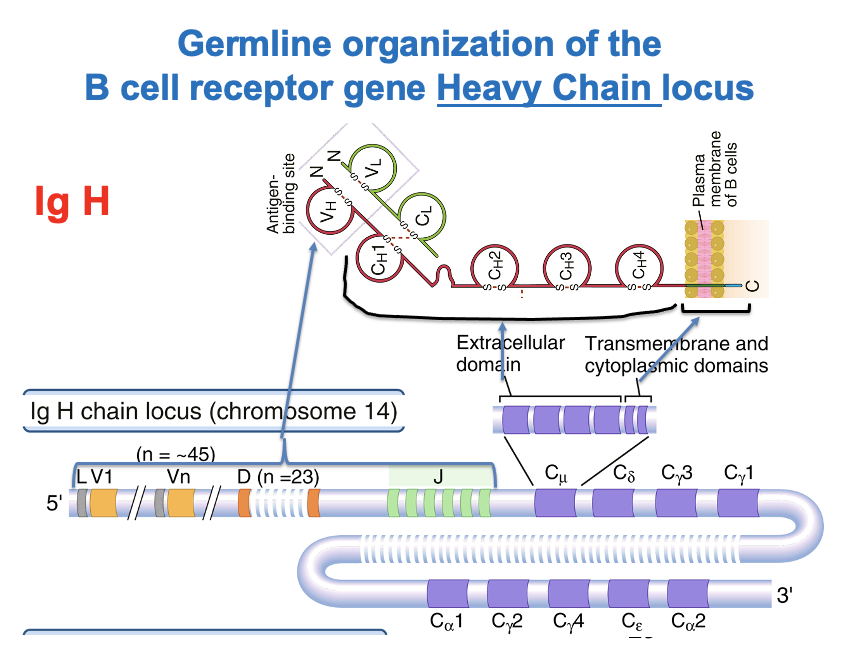
variable region of the gene will create the part of the protein which is the antigen binding site
this is how variable region is in IgH
germline organization of B cell receptor gene light chain locus
Ig K
Ig gamma
System shopping for pieces + putting together to make new combinations
Ex: wardrobe of 30,000 outfits
- by mixing outfits, there are 1.5x10^6 outfits total
Done at chromosomal level
- only done by immune B and T cells
- other cells don’t do this
how do you make a new gene in each b cell clone that never existed and cannot be inherited to the offspring?
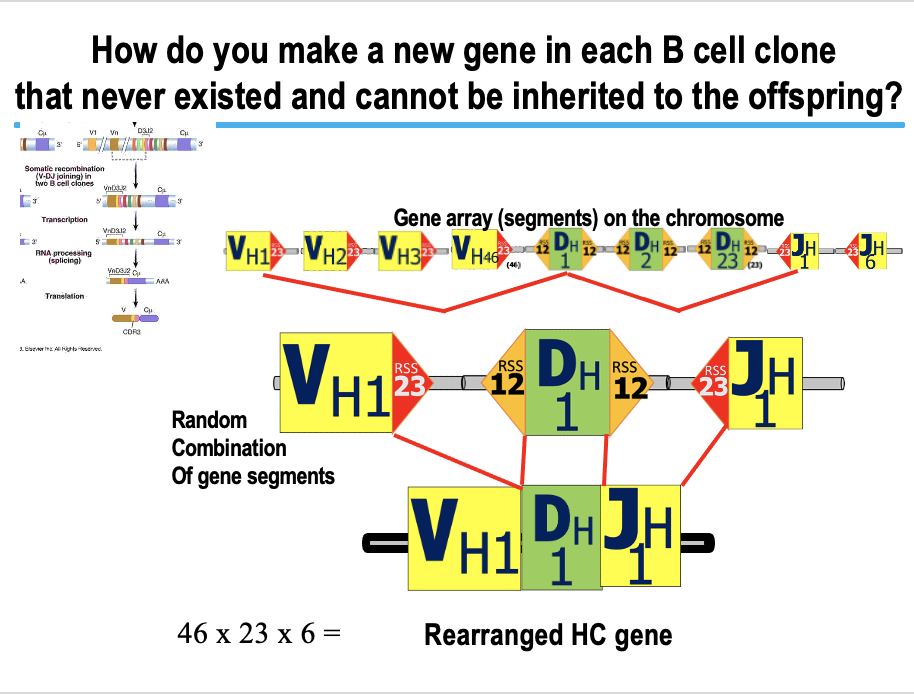
How this happens
Picks 1V, 1D, and 1J `and puts together
Order in process bc of DNA sequences surrounding the small V, D, J regions
- the red and orange
- red sequences cannot combine with red, and orange cannot combine with orange (keeps it orderly and correct)
- specific sequences cannot recombine with the same one (ex: 23 must be next to 12)
= so red must be next to orange
= makes order to rearrangement of genes
cont.
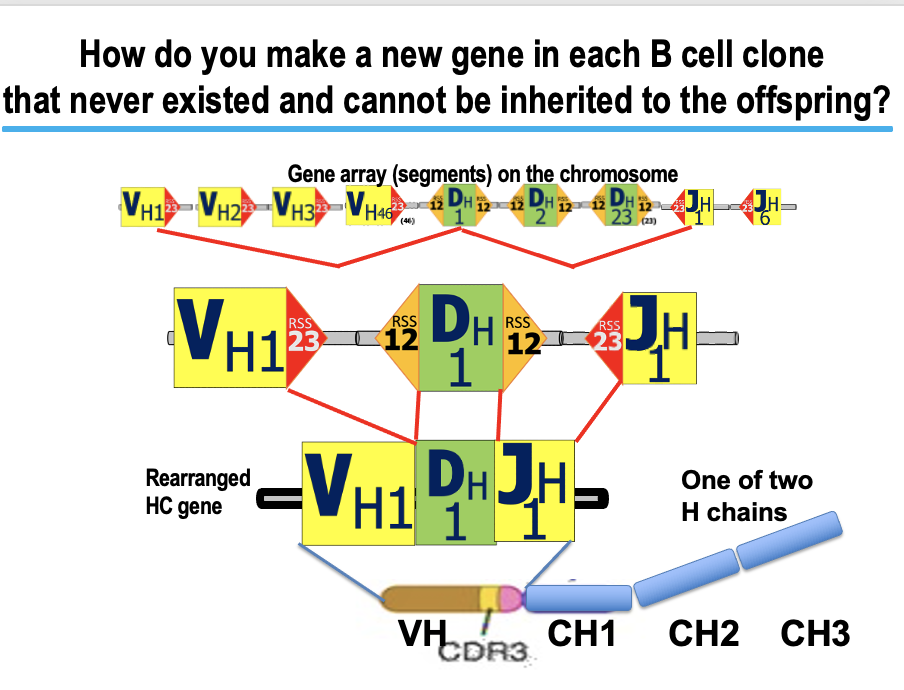
All this is to make variable binding site of antibody
recombination activating gene (RAG) 1 & 2
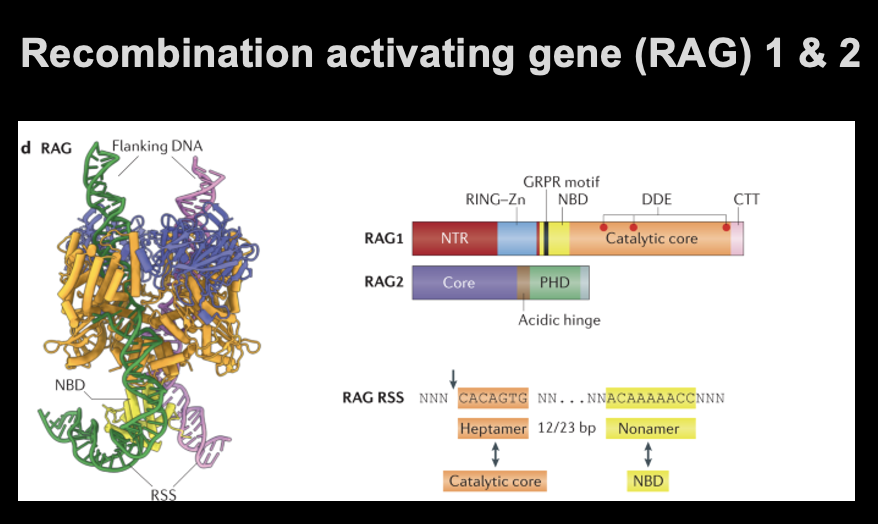
Gene in lymphocytes RAG 1 and 2
– imagine as a scissor that cuts DNA in right place (where the red/orange triangles were) to join them together (does the gene cutting for recombination)
before the VDJ segments can join together
Hardly any exons in these genes, not typical for human genes (human genes usually have a lot of exons)
V(D)J recombination occurs in the context of
what is
known as 12/23 rule
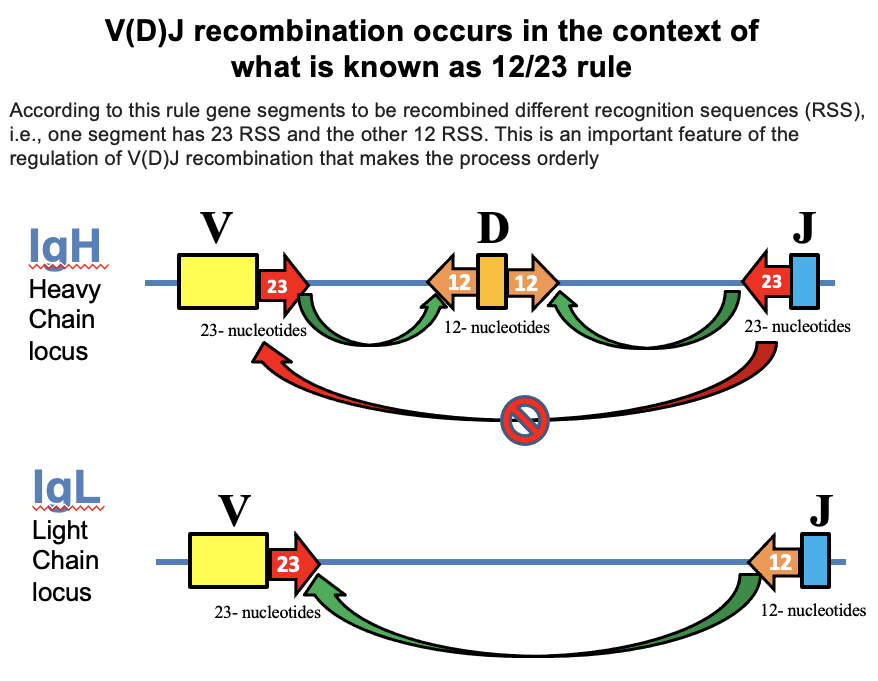
according to rule - gene segments to be recombined different recognition sequences (RSS)
- ex: one segment has 23 RSS and the other has 12 RSS
- important feature of the regulation of VDJ recombination that makes the process orderly
essentially, 23RSS must connect with 12RSS (so that the order ends up being VDJ)
Same idea – rule of can combine only red – orange or orange – red
In light chain, V and J can combine
generation of B cell diversity by recombination and expression of Ig genes
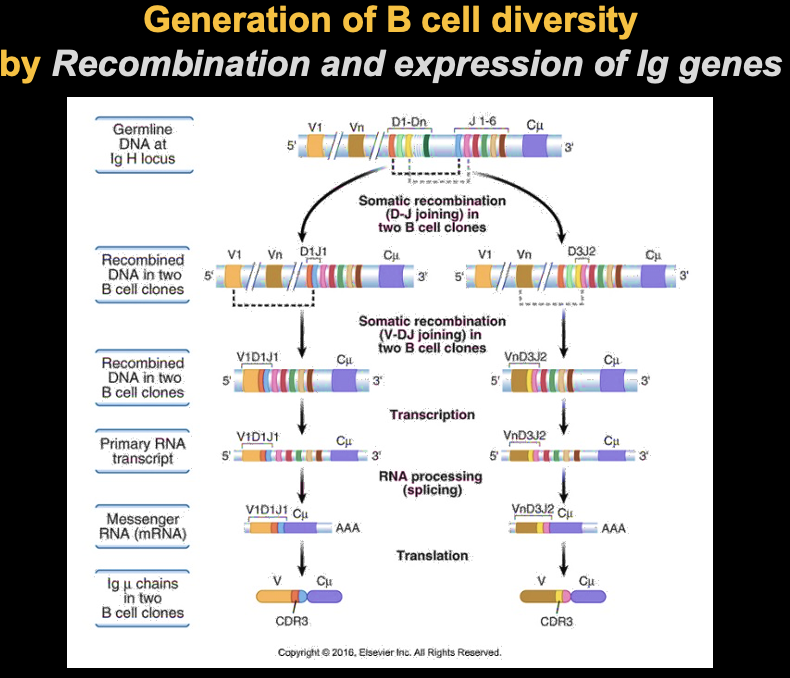
Basically show if u pick V1,D2, and J13
Making 2 diff genes in the 2 scenarios
potential Ig repertoire
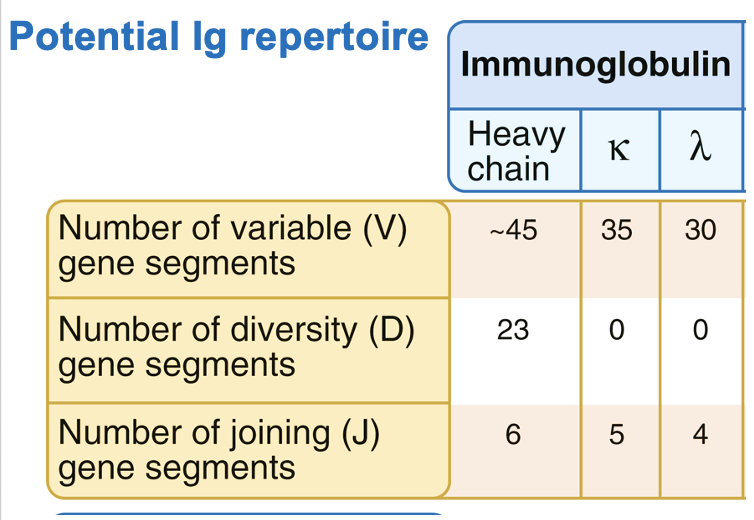
shows possibilities
VDJ gene recombination to make functional antibody genes (video)
Ig genes componsed of separated segments of DNA that become joined together by process called somatic recombination to make functional gene
- V (variable) gene segment
- D (diversity)
- J (joining) segment
gene segments that recombine have specific sequence motifs (recombination signal sequence, RSS)
protein complex with product of RAG 1 & 2 genes - bind to RSS motifs RANDOMLY among the gene copies (ex: out of all V randomly pick a V)
- pinch/bring gene segment together and clip genes in between = so the desired gene segments are now adjacent (are ligased together so they connect now) = recombination process completed
- cleavage creates a hairpin DNA at end of gene segments
- more proteins make complex with RAG protein complex, to join the 2 RSS ends (RAG complex is holding the cut out portion of the gene) = create closed circle of DNA -> no further role in process
video is NOT on test, too specific
- can test to see if there are enough lymphocytes in someone (can test for immunodeficiency) by testing for circular piece at end??? This may not be correct
Need immune system for action against outside things (not just for solely bodily function)
light chains have only V and J segments
light chains have only V and J segments
...
What makes the random recombination of V, D, and J gene segments an orderly process?
12/23 rule?
BCR vs. TCR diversity generation by VDJ recombination
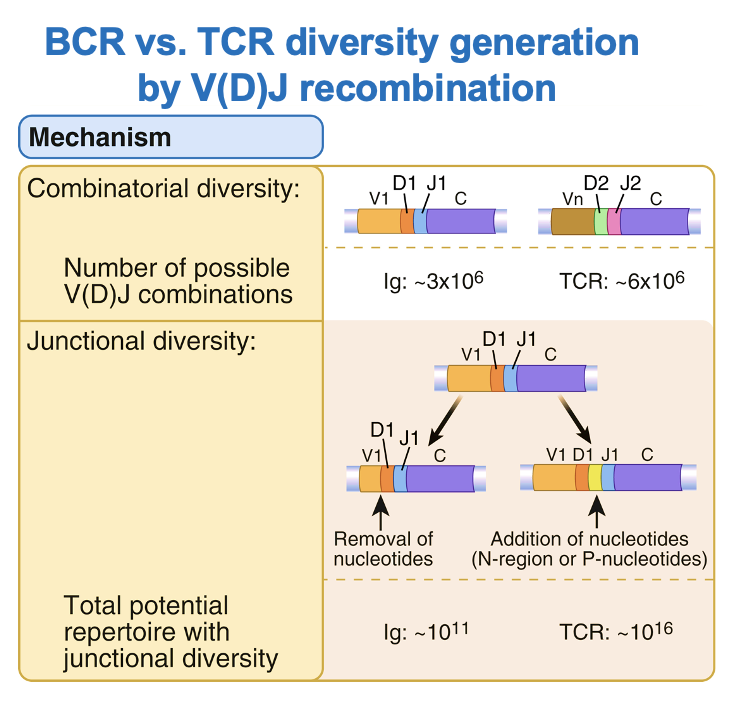
B cell dev steps coincide with VDJ recombination
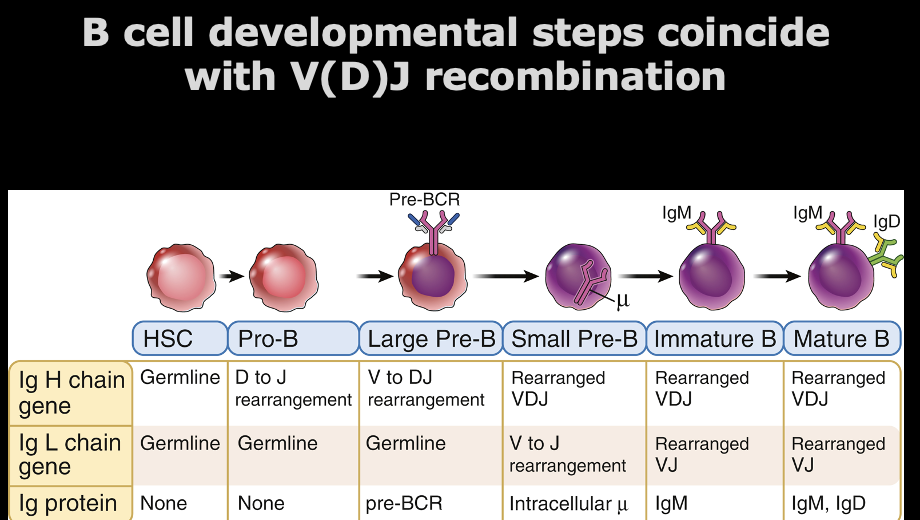
I dont understand this
Takaways
- unique structure of antibodies makes them versatile in their binding ability to antigen
- antibodies have Variable (V) regions (antigen binding) that make it possible to bind nearly unlimited number of antigens
- recombination activating genes (RAG) 1 & 2 are required to create antibody variable genes
- diverse VH regions are generated by a unique mechanism of genomic DNA rearrangement by random selection of V, D, and J gene segments (like exons)
- VH + VL together create vast and diverse binding specificities of antibodies
Antibodies have stable antibody structure
RAG genes required to make antibody variable genes
Together – heavy and light create receptor that together bind to antigen
- 3 fingers from light, 3 from heavy make …?
extra material after this in lecture slides
necessary? maybe review them later? i dont think he went over it